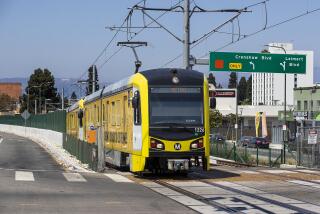MTA’s toll-lane project may be a victim of its own success

The conversion of the 110 Freeway’s carpool lanes into toll lanes was not without bumps: Some Angelenos feared that adding tolls to the Los Angeles County freeway network would further divide rich and poor commuters. Others groused that freeways should be free.
But two years later, the Metropolitan Transportation Authority project is on the cusp of becoming a victim of its own success: So many drivers now steer into the Harbor Freeway’s northbound toll lanes to escape morning traffic jams that the paid route is slowing down too. Over the course of a year, even as the per-mile toll crept toward the maximum, traffic in the paid lanes increased by almost 20% and speeds began to slow, officials say.
Metro officials are now experimenting with “carpool only” restrictions during the heaviest periods of morning rush hour, or about half an hour each day. Commuters who drive alone represent about one-third of total toll-lane drivers, and removing them immediately improves traffic flow, they say. But some researchers contend that restricting access is only a short-term fix: the real solution, they say, is to keep raising prices to reduce demand.
Metro’s algorithm modifies the per-mile toll as frequently as every five minutes, based on how many cars are using the lanes. Tolls range from 25 cents to $1.40 a mile, for a maximum one-way price of $15.40 along the 11-mile route. As cars enter the lanes, the price at that moment appears on overhead digital signs. In theory, a higher toll will discourage some drivers from using the lanes, freeing up space and speeds for the remaining users.
But that isn’t always happening. Paying the maximum charge along some miles of the route is “almost a guarantee” during the 5 a.m.-to-9 a.m. rush hour, said Kathleen McCune, Metro’s congestion reduction director. Even then, toll-lane traffic stays thick.
“The fact that the speeds are getting low suggests prices aren’t high enough,” said Clifford Winston, a Brookings Institute economist who focuses on transportation policy. “There’s no such thing as a price ceiling. If tolls went up to $10 per mile, I’m sure it would have an effect.”
But drivers who don’t pay tolls from their own wallets have made it more difficult for Metro to influence demand through prices, McCune said. Contractors, lawyers and consultants who bill clients for the toll will pay the price, no matter how high. “It could go up to $2,000 a mile and it wouldn’t matter to them,” she said.
Although $2,000 is an extreme example, that’s exactly what would happen, Winston said — and, he added, it isn’t a bad thing. “It’s economics,” he said. “The people who have the highest value on their time are the ones who are willing to pay the most.”
Val Wright, 40, an independent consultant in South Pasadena, uses the 110 toll route at least once a week during trips to Orange County, the Westside and Los Angeles International Airport.
“My time is very precious,” she said, adding that she has three daughters younger than 6. “I want to make sure I’m home as quickly as I can be.” Paying more wouldn’t be out of the question, she said.
The hybrid congestion pricing model in use in Los Angeles, Miami and Washington, D.C., can make freeways less efficient, Winston said. “It’s good to see that California is introducing these programs, but if you charge tolls piecemeal, you’re sowing the seeds of problems,” he said. “You don’t want anyone to pay nothing, because all that’s doing is potentially adding congestion in the ‘free’ lanes.”
Under a full-fledged congestion pricing plan, drivers pay to enter certain areas. In London, drivers pay more than $15 to drive to the central city between 7 a.m. and 6 p.m. on weekdays, which transportation officials say has reduced kilometers driven by 11% over a decade and paid for more than $1.7 billion in walking, bicycling and public transportation improvements.
Putting tolls on all of the 110’s lanes isn’t being discussed. However, Metro’s board of directors will probably consider an increase in the per-mile toll ceiling sometime this fall, McCune said, once staff has “tweaked the algorithm” as much as possible.
Standing in the way of higher fees is concern from some board members that a toll increase would re-ignite the traditional criticism that toll routes are “Lexus lanes” that leave low-income commuters stuck in traffic.
A solution to freeway congestion that doesn’t involve tolls, Winston said, may be in the works already: self-driving cars.
Taking the human error out of driving will “have an enormous effect on Los Angeles, because the traffic flow will be smoother,” Winston said. It won’t fix traffic, he said, but it could help cars use road space more efficiently. The cars are programmed to “play well together,” he said, including following at a closer distance, braking more smoothly and following traffic laws.
Follow @laura_nelson for transportation news.
Have an idea, gripe or question? Times staff writers Laura J. Nelson and Dan Weikel write California Commute and are looking for leads. Please send them along.
More to Read
Sign up for Essential California
The most important California stories and recommendations in your inbox every morning.
You may occasionally receive promotional content from the Los Angeles Times.











